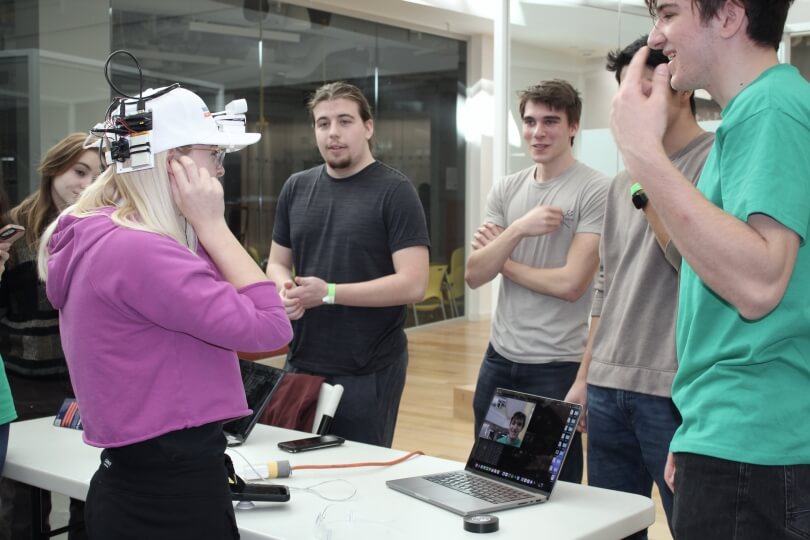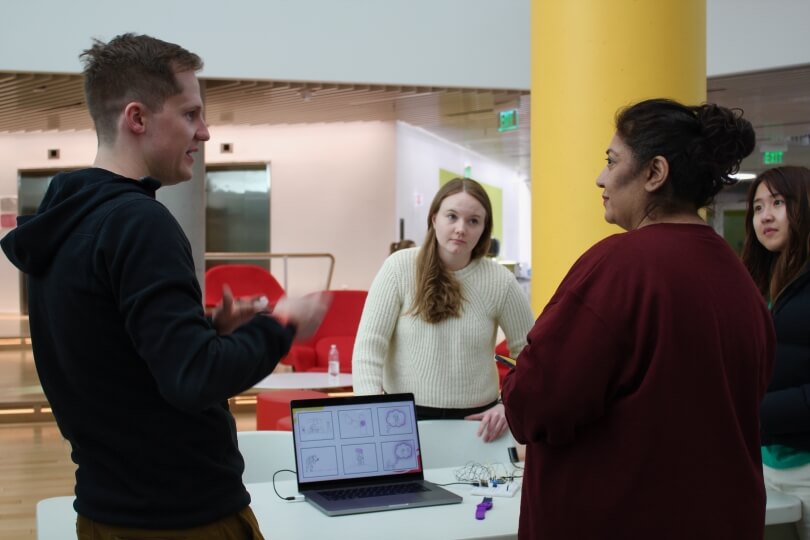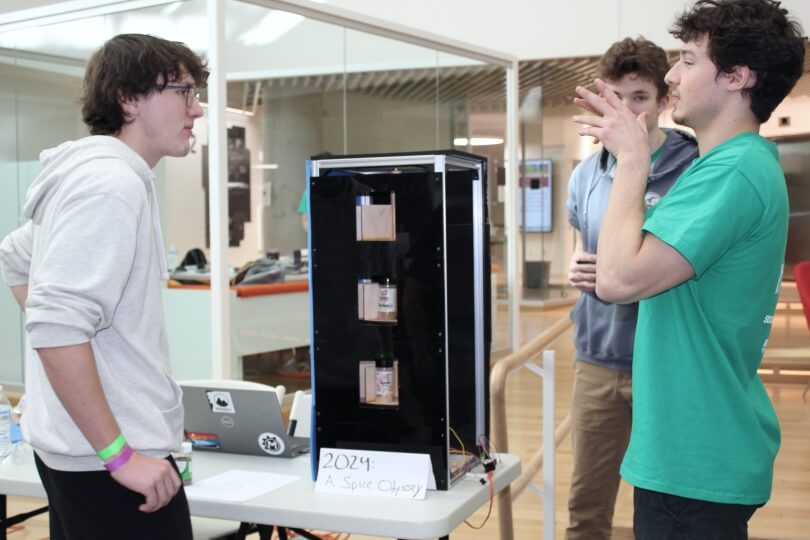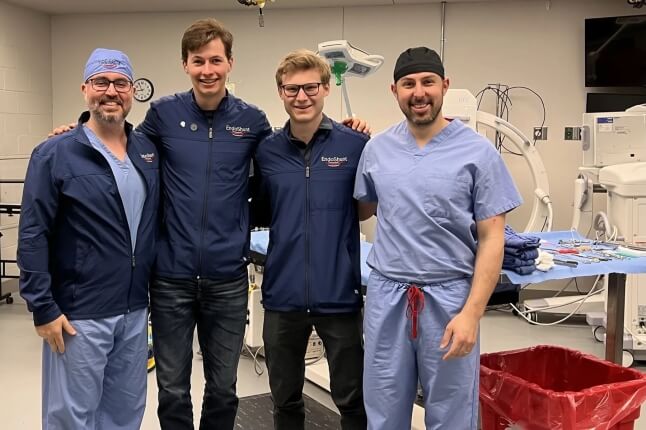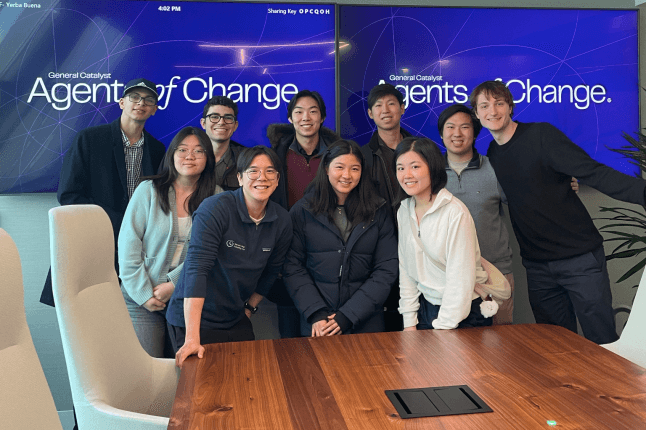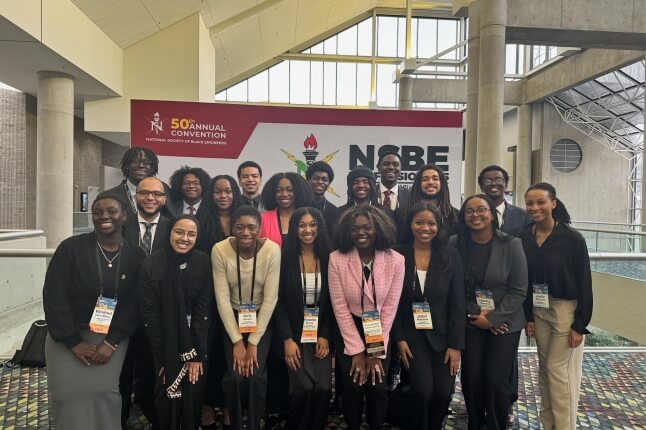News
The Harvard John A. Paulson School of Engineering and Applied Sciences (SEAS) isn’t just the engineering hub for the Harvard community — it’s become an intercollegiate destination for engineering and innovation.
MakeHarvard, a student-led 24-hour makeathon that began in 2018, recently brought students from across the country together at the Science and Engineering Complex (SEC). Thirteen teams, representing over 50 total participants, had 24 hours to design, build and present their devices. All manufacturing and construction was done in the SEC Makerspace facilities using materials provided by the event. MakeHarvard is a SEAS-affiliated student organization.
There are amazing ideas out there and it’s cool to see those ideas come to fruition each year.
“It’s a great example of how projects work in the real world," said Baltz, a fourth-year student pursuing a concurrent master’s in applied physics at SEAS. "You have to have a deliverable, and you have to finish it.”
Corporate sponsor Infosys devised a prize category for the device that best utilized artificial intelligence (AI), and many of the MakeHarvard projects incorporated AI in some way. Here’s a look at the winning designs, which took home a range of electronic gear and devices as prizes.
"Project Pair," an AI-powered facial recognition aid for the visually impaired, designed by University of Chicago students Robert Pitu, Trey Clark, Gideon Mitchell and Larry Li (Jennifer Nguyen)
BEST OVERALL: PROJECT PAIR
When Robert Pitu began his freshman year at the University of Chicago, he struggled to remember the names of all his new classmates. When it was time to design a MakeHarvard project, Pitu and U. Chicago Robotics Club teammates Trey Clark, Gideon Mitchell and Larry Li expanded that challenge to include the visually impaired.
Project Pair is an AI-enabled camera attached to the brim of a baseball cap. The device records the face of whoever it’s pointing at, extracts the image, and compares it to a directory of images of people the wearer knows. If there’s a match, the person’s name plays through attached earbuds.
“We worked on it piecemeal,” said Mitchell, a junior studying computer science and math. “Trey did the image processing, I did the networking code, Larry did the bluetooth integration, Robert did the hardware. We were stuck in integration hell for the last four hours, and getting everything to just click and work in tandem was an amazing feeling.”
SECOND PLACE: POWER STRIDE
Power Stride was devised by University of Rhode Island sophomore Jack Stadtman, Arizona State sophomore Mrinaal Arora and Wellesley freshman Khyatee Atolia. It is a knee brace with an electric generator. As the wearer bends their knee, the device generates electricity that can be used to either charge a smartphone via a USB cable or recharge batteries.
“All engineers should go through this,” said Stadtman, a mechanical engineering major. “You have these grand ideas, but as you hit roadblocks, you need to think on your feet. You’ll run into software problems, 3D-printing problems, things that engineers won’t encounter until they go into the workforce.
Atolia added, “When there’s pressure and deadlines, I think it can bring the best out of us.”
THIRD PLACE: OQIGA.AI
Oqiga.AI is an AI-driven storytelling application, whose name comes from a Kazakh word that can mean “story” or “adventure.” It was designed by Boston University students Zhakhangir Mamayev and Zhandos Brown.
MakeHarvard visitors learn about "mAI," a wearable storytelling device designed by Brown University/Rhode Island School of Design graduate students Katie Lynch, David James and Lisa Lo (Jennifer Nguyen)
INFOSYS BEST USE OF AI: mAI
Katie Lynch, David James and Lisa Lo designed mAI, a watch that uses AI to prompt imaginative play and storytelling for children. The watch suggests themes such as “cowboy” or “astronaut,” then prompts the wearer with tasks and challenges that promote physical activity and fulfill objectives within the story.
“Not only does it do word detection, but it also has an accelerometer,” said James. “In a future iteration, it could detect the kid’s motion and further encourage more movement, almost like a natural exercise routine.”
All three team members are graduate students in the Master of Arts in Design Engineering program run jointly by Brown University and the Rhode Island School of Design.
“2024: A Spice Odyssey,” a smart shelving system designed by Northwestern students Shawn Marine, Evan Queeney and Thomas Michel (Jennifer Nguyen)
MAKEHARVARD ORIGINALS: 2024, A SPICE ODYSSEY
Northeastern juniors Shawn Marine, Evan Queeney and Thomas Michel teamed up to design a smart shelving system known as “2024: A Spice Odyssey.” By speaking the name of a spice into a smartphone app, the shelf carousel rotates to make that spice available. By placing a new spice into an open spot on the shelf and saying its name into the app, the new spice is added to the database for future use.
“It made us really have to think on the fly a lot,” said Marine, a mechanical engineering major. “We ran into a lot of roadblocks, including some big-ticket items like the spinning functionality and mounting everything. It was a bunch of trial and error, and I feel like we really stretched our mechanical engineering abilities during this competition.”
Topics: REEF Makerspace, AI / Machine Learning, Allston Campus, Computer Science, Electrical Engineering, Events, Materials Science & Mechanical Engineering, Student Organizations
Cutting-edge science delivered direct to your inbox.
Join the Harvard SEAS mailing list.
Press Contact
Matt Goisman | mgoisman@g.harvard.edu
